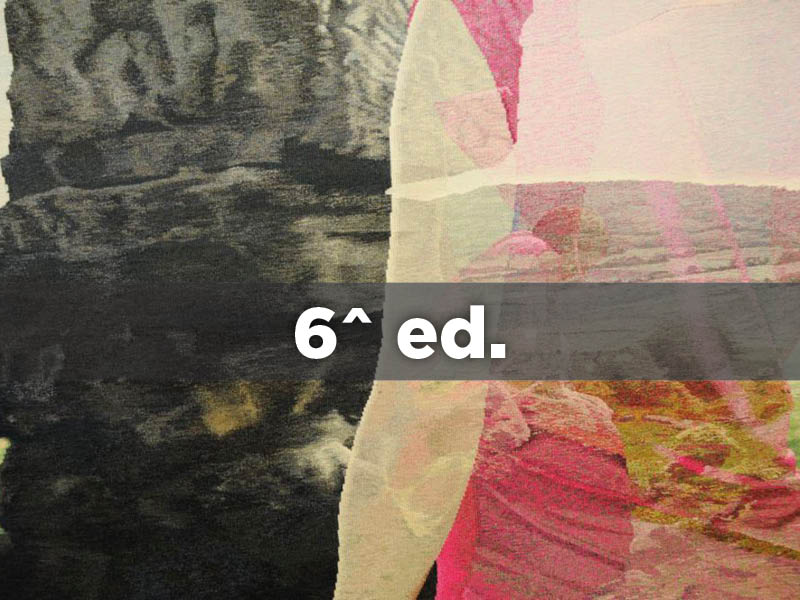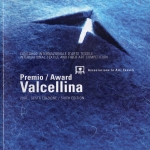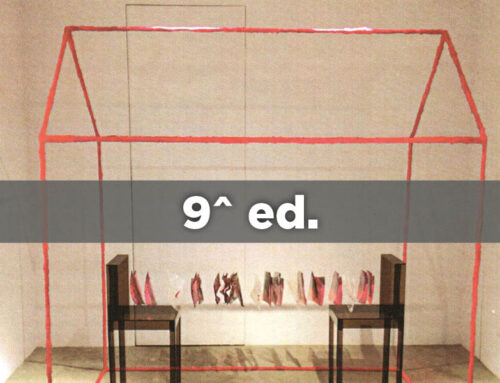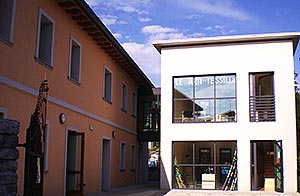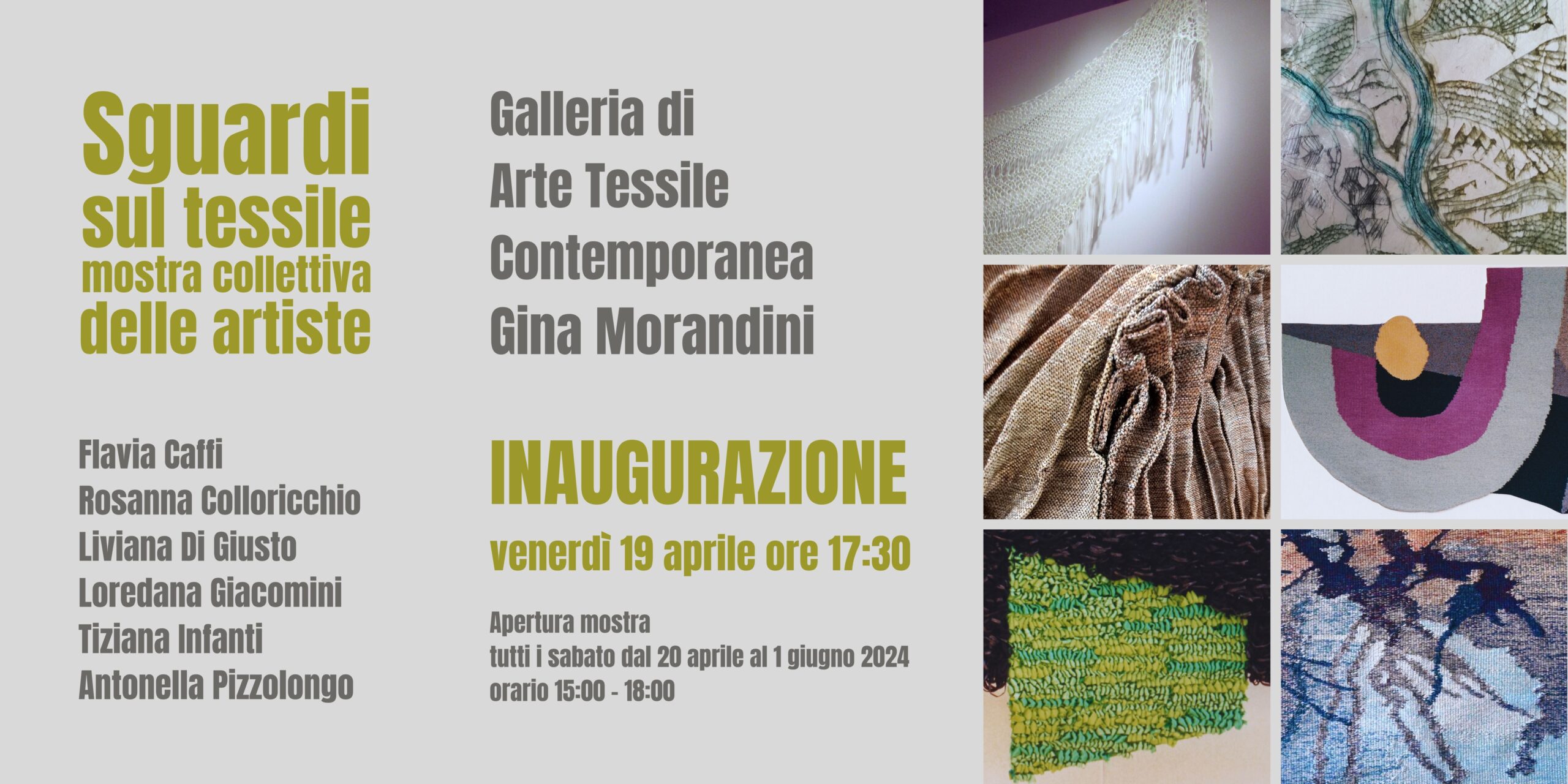Premio Valcellina, Concorso Internazionale d’Arte Tessile, 6^ edizione
Concorso aperto a tutti i giovani artisti tessili fino al compimento del 35° anno di età, nati dal 1 gennaio 1972
Valcellina Award, International Textile and Fiber Art Competition, 6th edition
Competition open to all young fiber artists under 35 years of age, born from 1st January 1972
Chiusura del bando 30 novembre 2007
Artisti 100 partecipanti, 46 selezionati ammessi al concorso
Inaugurazione e cerimonia di premiazione 19 aprile 2008, Museo CO.RI.CA.MA., Maniago PN
Durata dell’esposizione dal 20 aprile al 18 maggio 2008
Mostre collaterali
Premio Valcellina – Sezione ad invito, opere degli studenti Angelina Paavilainen e Petrina Laine dell’EVTEK Institute of Art and Design [Istituto di Arte e Design], Vantaa/Helsinki, Finlandia; Jacob P. Petersen e Maria Albertsen della Danmarks Designskole [Scuola di Design Danese], Copenagehn, Danimarca; Laura Giovannardi e Giorgia Manfredini May dell’Accademia di Belle Arti, Bologna; Szabo Gergely della Moholy-Nagy Művészeti Egyetem [Università di Arte e Design], Budapest, Ungheria; Eva Vasari e Michaela Götsch dell’Akademie der bildenden Künste Wien [Accademia di Belle Arti di Vienna], Vienna, Austria, Museo CO.RI.CA.MA., Maniago
Eventi collaterali
Il 18 aprile 2008 si è svolto Creatività/y – Convegno Internazionale sulla Didattica Innovativa dell’Arte Tessile/Fiber Art: Tecniche e Finalità con interventi di Lydia Predominato, Kirsi Niinimäki, Clare Johnston, Mary-Ann Hansen, Vanna Romualdi, Elisabeth Freiss, Silvia Kadolsky, Bianca Cimiotta Lami, Bényei Tünde, Eva Basile, Catherine Vandenbroecke e Patricia Christy, Teatro Comunale Giuseppe Verdi, Maniago
Sfilata di abiti-scultura: Nothing is what it seems (fashion Manifesto) [Niente è come sembra (Manifesto della moda)] di Laura Capriotti, Stella Cirelli e Roberto Di Stefano, Drop [Caduto] di Piero Cascioli e Silvia Recchia, Made in Child [Fatto nel Paese dei bambini] di Sara Battiston, Melissa Bruscoli, Josefin Englund dell’Accademia d’Alta Moda Koefia, Roma e il trittico Art Core [Nucleo d’arte] di Thea Langen, Christine Walf e Julia Knuepfer dell’Esmod, Berlino, Germania, Museo CO.RI.CA.MA., Maniago
Concerto del gruppo Clobeda’s, Palazzo d’Attimis Maniago, Maniago
Deadline for participation 30 November 2007
Artists 100 participants, 46 selected and admitted to the competition
Inauguration and award cermony 19 April 2008, CO.RI.CA.MA. Museum, Maniago PN
Exposition period from 20th April to 18th May 2008
Collateral exhibitions
Premio Valcellina – Sezione ad invito (Valcellina Award – Invitational section), works by the students Angelina Paavilainen and Petrina Laine of the EVTEK Institute of Art and Design, Vantaa/Helsinki, Finland; Jacob P. Petersen and Maria Albertsen of the Danmarks Designskole (Denmark Design School), Copenhagen, Denmark; Laura Giovannardi and Giorgia Manfredini May of the Accademia di Belle Arti (Academy of Fine Arts), Bologna; Szabo Gergely of the Moholy-Nagy Moholy-Nagy Művészeti Egyetem (University of Art and Design), Budapest, Hungary; Eva Vasari and Michaela Götsch of the Akademie der bildenden Künste Wien (Academy of visual art of Vienna), Vienna, Austria, CO.RI.CA.MA. Museum, Maniago
Collateral events
Creatività/y – International Meeting on Fiber/Textile Art Innovative Didactics: Techniques and targets took place on 18th April 2008 with speeches by Lydia Predominato, Kirsi Niinimäki, Clare Johnston, Mary-Ann Hansen, Vanna Romualdi, Elisabeth Freiss, Silvia Kadolsky, Bianca Cimiotta Lami, Bényei Tünde, Eva Basile, Catherine Vandenbroecke and Patricia Christy, Giuseppe Verdi Municipal Theatre, Maniago
Sculpture-clothes fashion show: Nothing is what it seems (fashion Manifesto) by Laura Capriotti, Stella Cirelli and Roberto Di Stefano, Drop by Piero Cascioli and Silvia Recchia, Made in Child by Sara Battiston, Melissa Bruscoli and Josefin Englund of the Accademia d’Alta Moda (High Fashion Academy Koefia), Rome and the triptych Art Core by Thea Langen, Christine Walf and Julia Knuepfer of the Esmod of Berlin, Germany, Museo CO.RI.CA.MA, Maniago
Live concert by Clobeda’s, Palazzo d’Attimis Maniago (d’Attimis Maniago Palace), Maniago
Giuria / Jury
Andrea Bruciati – Direttore della Galleria di Arte Contemporanea La Comunale, Monfalcone (GO) e critico d’arte / Director of the Contemporary Art Gallery La Comunale, Monfalcone (GO) and art critic
Daniela Degl’Innocenti – Curatrice del Museo del Tessuto di Prato (PO) / Curator of the Museum del Tessuto, Prato (PO)
Lydia Predominato – Fiber artista, ideatrice e curatrice di mostre di Fiber Art / Fiber artist, fiber art event maker and curator
Loredana Rea – Critica d’arte / Art critic
Stefano Sopelza – Responsabile contatti scuole e designer MittelModa Fashion Award / Shool and designer Contacts Coordinator MittelModa Fashion Award
Artisti selezionati, opere e premi assegnati
Selected artists, works and prizes awarded
PRIMO PREMIO / FIRST PRIZE
Margot J. Pernerstorfer (Austria / Austria) Posti passati / Passed places
SECONDO PREMIO / SECOND PRIZE
Christy Matson (USA / USA) Gradiente rumore II / Gradient noise II
TERZO PREMIO EX-AEQUO / THIRD PRIZE JOINT WINNER
Nao Fukumoto (Giappone / Japan) Conchiglia sulla spiaggia / Shell on the beach
Deepa Panchamia (Regno Unito / United Kingdom) Syksy / Syksy
PREMIO CALIMALA/ CALIMALA PRIZE
Maria Barbara De Marco (Italia / Italy) Confidenze / Confidences
MENZIONE SPECIALE / SPECIAL MENTION
Magdalena Grenda (Polonia / Poland) Geometria organica / Organic geometry
Signe Møller Jensen (Danimarca / Denmark) Semi lavorato a maglia / Barely knit
Megan Price (Canada / Canada) Decisioni divise / Split decisions
Chloè Rousset (Francia / France) Frammenti di paesaggio / Land in rags
Parul Thacker (India / India) Luce tessuta / Woven light
—
Magdalena Artusi (Italia / Italy) Preghiere bianche / White prayers
Anna Maria Atturo (Italia / Italy) Tela… ordire il giallo / Plain weaving… yellow warp
Ulrika Berge (Svezia / Sweden) Scorrere / To flow
Anthea Bush (Regno Unito-Olanda / United Kingdom-Holland) Icarus [Icaro] III / Icarus III
Marzia Camerin (Italia / Italy) Ri-legatura – Genesi / Re-binding – Genesis
Alessio Campo & Patrizia Miggiano (Italia / Italy) Gabbia androgina / Androgynous cage
Domenico Carella (Italia / Italy) Tappeto / Carpet
Maria Vittorio Castaldello (Italia / Italy) L’Inganno dell’attesa / Deceitful waiting
Daniela Costanzo Giorgio (Italia / Italy) Le temp est passè [Il tempo è passato] / Time has passed
Beatrice Da Col (Italia / Italy) Ri-legatura – Sulla strada / Ri-biding – On the road
Muge Durmaz (Turkia / Turkey) Peperoncino rosso seccato / Dry red hot pepper
Aglaia Haritz (Svizzera / Switzerland) Guerra II / War II
Matthias Holz (Germania / Germany) Due strati / Two layers
Chiara Intropido (Italia / Italy) Il cuscino / The cushion
Sunna Kangas (Finlandia / Finland) La breve storia del respiro / The short history of breathing
Zane Kokina (Lettonia / Latvia) Variazioni / Variations
Kazuhito Maekawa (Giappone / Japan) Tu, io e le mele avvelenate / You and I and poisonous apples
Marina Majcen (Italia / Italy) Ex Voto / Ex Voto
Francesca Marcon (Italia / Italy) Connessione impossibile… o quasi! / Impossible… or almost impossible connection!
Emma McClintock (Regno Unito / United Kingdom) Lavoro ad ago / Needlework
Raffaella Norcini Pala (Italia / Italy) La vita stretta / Slim waistline
Nadia Odorico (Italia / Italy) Germinatoio / Seed tray
Yoshimi Okamoto (Giappone / Japan) Senza titolo / Untitle
Seçil Özçinar (Turkia / Turkey) Il sogno dei dervisci rotanti del sufismo / The dream of the whirling dervishes of sufism
Veronica Pecci (Italia / Italy) Archivio familiare / Family files
Alessandra Ruo (Italia / Italy) Ossi di seppia / Cuttlefish bones
Martina Sartor (Italia / Italy) Ri-legatura – Il libro / Re-binding – The book
Agnese Scavolini (Italia / Italy) Mattia / Matthias
Bianca Maria Sitzia (Italia / Italy) Ganesh Yantra / Ganesh Yantra
Linda Thalmann (Austria / Austria) 01 – Inizio/Fine / 01 – Begin/End
Justin Randolph Thopson (USA / USA) Foglia di palma / Palm leaf
Miriam Tourn (Italia / Italy) Eclissi 07 / Eclipse 07
Pei-Shan Wu (Taiwan R.D.C. / Taiwan R.O.C.) Rifugio n. 1 / Shelter No. 1
Nao Yoshimoto (Giappone / Japan) Tessuto della memoria ’07 / Texture of Memory ’07
Lidia Zhukova (Russia / Russia) Pesce volante / Flying fish
Saggio critico / Critical essay
Quello che un artista può offrire ad uno spettatore e quello che uno spettatore può interpretare da un’opera d’arte è un rapporto molto intimo e personale. Mostre e musei come Ie gallerie d’arte e i concorsi di visual arts sono tra i Iuoghi d’incontro più comuni tra I’artista e un suo potenziale pubblico o spettatore. Internet, Ietteratura, carta stampata, comunicazione sono passi ulteriori che approfondiscono questo difficile talvolta unico rapporto tra artista e spettatore.
Spesso troviamo limiti alla pura interpretazione, così come limiti alla pura espressione, limiti dettati da Ieggi dei mercato, da trends, dai materiali utilzzati, dai colori, dal progetto stesso ma vi sono dei momenti dove ogni artista può esprimersi al meglio e ancor di più può confrontarsi con aItri artisti, approfondendo Ia propria ricerca, Ia propria storia, Ie proprie emozioni.
Se ci chiediamo cosa è ARTE, sarebbe come chiedersi quante onde vediamo in un oceano, tante e anche nessuna.. così arte può essere tutto e anche niente perché vi e una chiara componente soggettiva. Una cosa sola può essere concordata: I’arte non ha confini, non ha bandiere e soprattutto può essere espressa in mille forme.
L’arte tessile, Iegata alla visual art ma anche alla ricerca di materiali, è un’importante componente della nostra quotidianità.
In questo momento di incontro tra arte e pubblico iI concorso di fiber art Premio Valcellina ricopre un ruolo fondamentale.
Artisti di fiber art, come per ogni forma d’arte, necessitano però di spazi e momenti, ecco perché iI Premio Valcellina, e i workshop e Ie mostre ad esso collegati assumono un importante ruolo nel panorama artistico nazionale ed internazionaie.
Siamo stati chiamati a valutare opere provenienti da tutto iI mondo, opere diverse tra Ioro, ma con un comune denominatore: I’espressione e Ia comunicazione attraverso Ia fibra tessile e Ia sperimentazione della stessa in ambito artistico.
I risultati sono stati eccelienti, avendo i candidati dimostrato talento, creatività e soprattutto grande capacità neII’uso dei materiali, delle forme nel voler sviluppare i propri progetti artistici in maniera indipendente, Iibera da ogni costrizione o Iimitazione.
Abbiamo incontrato molte variabili tra i lavori, come una variabile geografica che accorpa artisti orientali, una tecnologica che accomuna artisti nordamericani, una tradizionale, una concettuale ma in tutti i casi il risultato ottenuto risultava sempre valido.
II Premio Valcellina, organizzato con scadenza biennaie in modo molto professionale da Le Arti Tessili con Ia supervisione delie fiber artists Gina Morandini e Lydia Predominato, può essere considerato uno dei maggiori momenti ed eventi di arte tessile nel panorama nazionale e risulta essere un fondamentale punto di incontro per artisti internazionali, docenti ed esperti di fiber art mondiali.
Quanto visto e valutato Io scorso 15 marzo a Maniago, è espressione di artisti provenienti da tutto iI mondo, dai 5 continenti.
Potere deIIa giobalizzazione, ma anche potere deII’arte e capacità da parte degli organizzatori, e di chi ha creduto in questo concorso, di saper coniugare arte, comunicazione, cultura in un contesto provinciale come Maniago. La scelta e azzeccata, permettendo un’azione di marketing territoriale e turistico Iegata alla forma d’arte, ed unendoli in un felice matrimonio culturale. L’importanza di coniugare iI concorso con Ia mostra da al Premio Valcellina una globalitò, una sua importanza, una sua natura che rende iI Premio stesso unico.
Se guardiamo iI panorama dei concorsi in ambito europeo o mondiale, notiamo spesso dei cicli che portano i concorsi ad esaurirsi e a cambiare format a seconda di esigenze dettate dai mercato o dagli stessi sponsors. II Premio Valcellina neIIe sue sei edizioni ha mantenuto Ia sua natura divenendo un appuntamento fondamentale per scuole, designers, artisti e docenti desiderosi di potersi ancora una volta confrontare con Ie opere d’arte esposte. Credo fortemente nelle potenzialità del Premio Valcellina, e quanto questo possa essere importante per Ia fiber art e per gli artisti di fiber art di tutto il mondo: un momento di incontro, di scambio e di arte e cultura unico e fondamentale nel percorso formativo di ogni giovane artista.
Ancora una voita grazie, Premio Valcellina, e un grosso IN BOCCA AL LUPO per iI futuro deIIa manifestazione.
di Stefano Sopelza, Responsabile contatti scuole e designer MittelModa Fashion Award, giuria Premio Valcellina 6^ edizione
What an artist can offer the public and what the public can understand of an art work, is a very intimate and personal relationship. Exhibitions, museums, art galleries and visual arts competitions are the most common meeting places for the artist and his/her potential public. Internet, literature, printed news, and mediatic communication further make the relationship between artist and public deeper. We often find limits to the mere interpretation, as well as to pure expression.
These are limits fixed by market laws, trends, use of materials, colours, and the project itself. There are, however, occasions when each artist can express him/herself at his/her best, and confront with other artists in order to better understand in depth his/her research, history, and emotions.
If we ask ourselves what ART is, it would be the same thing as asking how many waves we see in an ocean – many but perhaps none… So, art can be everything but also nothing because the subjective component clearly plays an important role.
Nevertheless, threre is some agreement: art does not have limits, is under no specific flag, and most important, can be expressed in thousands of forms.
Textile art, which is connected with visual art but also with material research, is an important component of our everyday life.
In this connection, the Valcellina Award plays a role of paramount importance in favouring the art and public‘s encounter.
Fiber artists, and artists of other kinds, need spaces and events. This is the reason why the Valcellina Award, and related workshops and exhibitions, play an important role within the national and international artistic panorma.
We have been invited to evaluate works from all over the world, all different works but with a common connotation: expression and communication by means of the textile fiber, and its experimentation with an artistic approach. The results are excellent since the candidates have shown talent, creativity, and most of all a great ability in the use of materials and forms.
They have also developed their artistic projects in an independent manner, free of any constraint or limitation.
We have noticed many variables among the works: a geographic variable grouping oriental artists, a technological one typical of North American artists, a traditional, a conceptual one but in all cases the result obtained is absolutely valid.
The Valcellina Award, a biennial event, is curated by two fiber artists, Gina Morandini and Lydia Predominato, in a highly professional manner. lt can be considered one of the major textile art momenta and events on the national scene, and also a fundamental meeting point for international artists, fiber art teachers and experts from all over the world.
The oeuvres we juried last lvlarch 15th in Maniago belong to artists from the five continents. This is the result of globalization and also the power of art and the ability of the organizers, and of those who have believed in it, to combine art, communication, and culture in a provincial context like Maniago. The choice is fortunate since it brings about an action of territorial and tourism marketing connected with art, in this way effecting a happy cultural mix.
The fact of combining the competition with the exhibition gives the Valcellina Award globality, importance, and a connotation which make it a unique event.
If we give a look at the European or world competitions, we may often notice that they cyclically give up or change format according to the market’ or sponsors’ exigencies. The Valcellina Award in its six editions has remained the same and become a central appointment for schools, designers, artists, and teachers eager to visit the exhibited oeuvres.
l strongly believe in the Valcellina Award’s potentiality and its importance for fiber art and fiber artists around the world – a unique occasion to meet, exchange art and culture along the formative itinerary of each young artist.
Once more thank you, Valcellina Award, and a big BREAK A LEG! for the future.
by Stefano Sopelza, Shool and designer Contacts Coordinator MittelModa Fashion Award, jury member of Valcellina Award 6th edition

